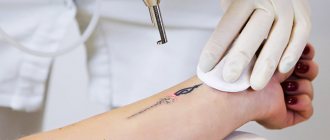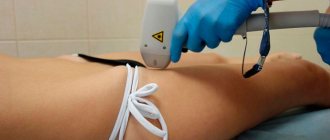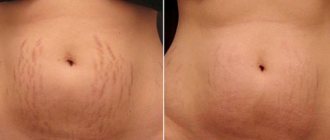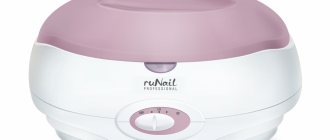Tattoos are not always the result of a carefully considered and balanced decision. In a fit of emotion, it’s easy to go into the first beauty salon you come across and fill yourself with the name of your beloved or a drawing that comes to mind. And only then, when rationality takes over again, do we begin to think about how to remove a tattoo, made on emotions.
You can want to get rid of a pattern on your body for various reasons, everyone has their own. However, before going to the salon, it is worth finding out more information about the tattoo removal process itself.
Bath
It is believed that if you get an unsuccessful tattoo, then going to the bathhouse and increased sweating will save you and the tattoo will disappear. The logic is simple: if the master prohibits a bath immediately after the procedure, then by doing the opposite, you can get rid of the drawing.
The bathhouse is prohibited, first of all, because thermal procedures stimulate lymphatic drainage and increase blood circulation. The tattoo will remain, but pronounced tissue swelling, which will disrupt the vital activity of skin cells, can last up to a month.
Tatiana Kleiman
What do you need to know?
If tattoo removal is a resolved issue, then you should come to terms with a few things:
- Whatever method is chosen, the process will be accompanied by painful sensations. Their intensity depends on the pain threshold: some will not feel much discomfort, while others will need to use anesthesia.
- Quick removal is almost impossible. Most methods require more than one session with a cosmetologist
- Most likely, a scar, pigmentation or scar will remain in place of the reduced pattern.
- Removing a tattoo at home or by an incompetent tattoo artist is dangerous to your health.
- You cannot reduce a drawing drawn less than two months ago.
Remover
Remover is a special brightening liquid that is used both in correcting microblading and tattooing, and for removing artistic tattoos. First, it is injected, like pigment, under the skin, and then this place is treated with a certain composition to consolidate the effect.
Now there are many offers on the remover market, some are good for removing organic pigments, others are good for inorganic pigments, and others work with both. Definitely an effective method. However, you need to follow the recommendations and apply the remover at home for a long time.
Tatiana Kleiman
How are tattoos removed in salons?
In a cosmetology salon, a master can offer several methods for removing tattoos. Each of them has both advantages and disadvantages.
Camouflage method
A new one is applied in place of the old pattern, using a masking pigment. Essentially, this is the same tattoo, only in skin tone.
Among the advantages, the only thing that can be highlighted is that in this way you can correct a small flaw in the tattoo; it is not recommended to remove the design with camouflage. The disadvantages include:
- Camouflage is not suitable for tanning. As your skin tone changes, the camouflage “spot” will stand out.
- This method cannot cover a large drawing.
- If the color of the tattoo is saturated, the old pigment may show through the camouflage layer.
- The old pigment is mixed with the new one.
- The flesh-colored pigment will begin to change color over time.
Covering up with a new tattoo
A simple solution if you are tired of the old tattoo, but there is no desire to remove the drawing completely. In order for the new tattoo to fit onto the skin without any problems, the old pigment can be specially removed according to the artist’s recommendations. In this way, it will not be possible to make the new picture light enough to completely cover the old picture or inscription.
Skin excision
Before the introduction of lasers, excision was the only way to reduce unnecessary patterns. The tattoo will be a thing of the past in one session, but will leave behind unpleasant scars.
The essence of the method is that the surgeon removes part of the skin and tightens the remaining one. Recovery may take a long time.
Chemical peeling
It is produced using phenol, which is why it is not popular: this acid is dangerous to health. In addition, chemical peeling is extremely painful and is performed under anesthesia.
After the procedure, there is a long period of rehabilitation; sometimes the consequences of using chemicals manifest themselves after years. However, the method has several advantages:
- The procedure costs significantly less than others.
- Small patterns with superficial pigment are produced very simply.
- Removes any color from the design without any problems.
Cryosurgery
Liquid nitrogen is used to remove tattoos. A cloth soaked in it is pressed against the body to form an ice crust. After about two hours, the damaged area swells, sometimes a bubble with liquid forms on it. On the third day after the procedure, a dry crust remains on the skin, which disappears over time.
Disadvantages of the cryogenic method:
- Take a lot of time.
- Painful.
- It takes a long time to recover.
- Impressive people may feel ill from the consequences of the procedure.
- After tattooing, scars remain that disappear over time.
Electrocoagulation
Tattoos are cauterized using high-frequency current through electrodes. The procedure is performed exclusively using local anesthesia. If the specialist performing the procedure is poorly qualified, burns may remain.
After electrocoagulation, a crust forms on the affected area, which falls off after a week. As a result, a scar will remain. You can reduce tissue scarring if you follow the cosmetologist’s instructions after the procedure and use healing ointments.
Dermabrasion
A simpler name for the procedure is skin resurfacing. It is carried out using a diamond cutter.
The essence of the method is to remove layers of skin with pigment. The disadvantages include:
- Complete tattoo removal may require up to three sessions.
- After dermabrasion there is a long period of rehabilitation.
- The procedure significantly reduces the protective function of the dermis, which increases the likelihood of infection.
- After dermabrasion, it is necessary to properly care for the skin using disinfecting ointments and dressings.
- Dermabrasion leaves scars that are difficult to get rid of.
- The procedure does not remove deep-lying pigment well. It is also not used to reduce large tattoos.
The procedure requires a cosmetologist with extensive experience and high qualifications.
Laser removal method
Laser is considered the most advanced method of tattoo removal. It has a targeted effect and burns out pigment, minimally affecting the skin. Clean fabrics are not harmed.
In salons, when removing tattoos, various types of lasers are used:
- Ruby. It produces green color, but does not cope well with deep-lying pigment and red elements of drawings. Works slowly, so the session may last longer than usual.
- Alexandrite. For him, removing an inscription tattoo is a simple task. Works well with surface pigment. Faster than ruby, but also does not cope well with auburn reds and pinks.
- Diode. Copes with shades that Alexandrite and Ruby do not take. After using the Diode Laser, hair no longer grows in the areas where it has been treated because it damages the hair follicle.
- Neodymium. The latest generation universal laser. It copes with both dark and bright colors and burns them out from the deep layers of the dermis without any problems. Does not cause tissue scarring.
The laser beam is able to penetrate deep into the skin. This is true if the tattoo artist was not experienced, and the pigment lies on the deep layers of the dermis.
The procedure does not cause much pain, but local anesthesia is used if necessary.
The laser has only three disadvantages:
- Laser tattoo removal requires several sessions to fade the design, but one treatment does not last long. Ten minutes is usually enough to treat a small palm-sized area.
- Blisters may form after the laser. They pass within a month
- The procedure is expensive.
Laser vaporization
Otherwise, ablative tattoo removal. The method involves evaporating the pattern using a laser beam.
The method is only suitable for mixing professionally made tattoos with shallow pigment. If the paint is below the epidermis, then part of the pattern may remain after the procedure. Moreover, vaporization can seriously damage the skin.
Using a remover
A remover is a liquid specially created for correction during tattooing. She is also good at removing tattoos.
The remover is injected under the skin, which is then treated with an additional composition. This allows the discoloration of the pigment to be fixed.
When using this method, you should pay attention to the selection of remover. Some of them remove only organic pigments, others do not remove them at all. Those removers that have the same effect on pigment from any component are more expensive.
The procedure is carried out exclusively in salons to protect the tattoo remover from infection.
Contraindications to tattoo removal
Unfortunately, the list of contraindications is huge:
- Skin diseases.
- Injuries at the site of the tattoo.
- Predisposition to keloid scars.
- Diseases of the cardiovascular system.
- Epilepsy.
- Fresh tan.
- Diseases from the field of oncology.
- Pregnancy, lactation period.
- Diabetes mellitus in the decompensation phase.
- Blood diseases.
- Infectious diseases.
- Taking medications that are photosensitizers.
- Thrombosis, varicose veins at the tattoo site.
- Also, tattoos are not removed until the person turns 18 years old.
- The presence of “golden threads”.
If it is not possible to remove a tattoo due to contraindications, do not rush to get upset!
There are many methods for disguising unwanted patterns on the skin:
- Using regular cosmetics.
- Using special cosmetics for tattoos.
- Self-tanning.
You should not use tattoo camouflage methods only if it is still fresh. You can apply cosmetics or self-tanning to the tattoo site only after it has completely healed.
Objective assessment of the situation
Before removing a tattoo, you should consult with a tattoo artist who has a certain specialization and experience. But if you dare to remove a tattoo yourself, you need to approach this process very carefully. Look at the situation objectively to see if everything is really that bad, and whether you need to get rid of it. You must understand that home methods do not always bring the desired result, and the color and structure of the skin may not be restored.
Thermocoagulation
An increase in temperature in the upper layers of the skin, leading to tissue coagulation (thermal burn) and subsequent rejection along with the tattoo, is carried out using a continuous laser or infrared radiation. (This is a variant of the non-selective use of a laser source, in which it plays the role of a conventional heating element; the selective method will be discussed below).
Advantages of the method:
- high speed of the procedure;
- sufficient efficiency for superficial images.
Flaws:
- soreness;
- low effectiveness when the pigment is deeply buried;
- long-term healing of the burn surface;
- formation of visible scars.
Use proven and safe methods
And here a reasonable question arises: why bother and take such risks? All home removal methods are as artisanal as possible. Technology has come a long way.
Today you can come to the studio and have your tattoo completely removed in just a few sessions. For example, laser is actively used. It works precisely and effectively. You will watch as the tattoo gradually becomes lighter and eventually disappears from your body completely.
When using laser and other professional removal methods, you will get a noticeable, high-quality effect. The health risk will be minimal, and the recovery period will not take much time. There is no risk of infection, suppuration, large burns or ugly scars.
We recommend that you do not use home methods under any circumstances.
They pose a real danger and can lead to serious negative consequences for the body. Modern professional tattoo removal is affordable and is carried out using proven technologies. Share link:











